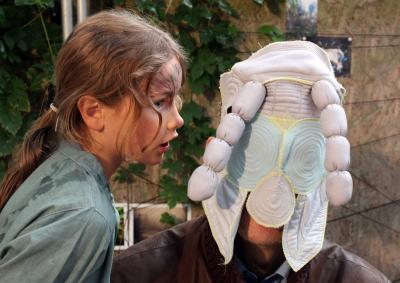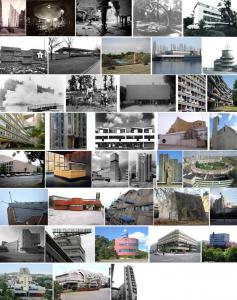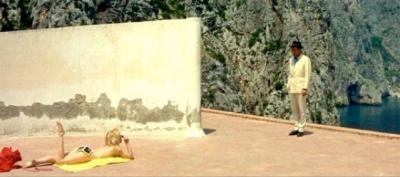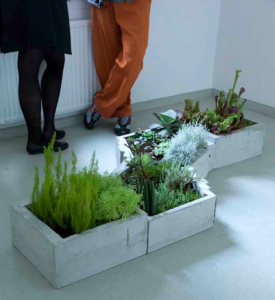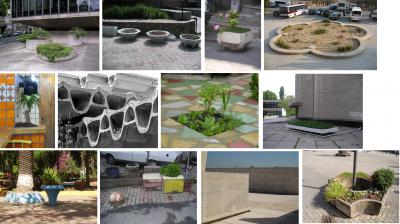Künstlerische Leitung, Choreografie: Barbara Schmidt-Rohr/Tanzinitiative Hamburg
Installation, Ausstattung, Kostüme: Isa Melsheimer
Choreografie: Frank Willens, Maria F. Scaroni
Performance: Roman Blackstein, Bela Brillowska, Oskar Chodzinski, Fanny Cold, Anna Foth,
Nikita Gusev, Jannis Jöns-Anders, Ella Simons
Mitarbeit: Eva Bernhard, Meike Klapprodt
Dramaturgie: Thomas Schaupp
Musik, Sound: Richard von der Schulenburg
Produktionsassistenz: Marie Golüke
Make-Up: Patrick Mai
The Bee Treasure, Internationales Sommerfestival auf Kampnagel Hamburg,
EXPEDACTION: Le Corbusier, Pierre Jeanneret, Charlotte Perriand,
June 11, 2011 - July 10, 2011
032c Workshop, Brunnenstr. 9, 10119 Berlin
CUM TO CHANDIGARH
By Carson Chan
On a bleary, shadowless day this past January, Chandigarh’s coldest day in thirty years, Le Corbusier, his cousin Pierre Jeanneret and Charlotte Perriand, their gamine friend and protégée, processed down the ramps of the city’s Assembly Hall. It has been more than half a century, but the three friends knew the place well.
After leading India to independence on a balmy August 15 in 1947, Jawahar Lal Nehru, the sub-continent’s Kashmiri Pandit son who became the country’s first President, followed his vision to raise a new, modern city. Le Corbusier and Pierre—who would forever be confused with Charles-Édouard Jeanneret, Le Corbusier’s birth name and alter ego—along with some other architects were entrusted with the new city’s design. Laying at the heels of the Shivalik hills before they climb into the Himalayas, Chandigarh was to be Nehru’s northern stronghold of power; These men would build it of concrete—great expanses of it would erupt into buildings, shapely, majestic horns of which would house generations of policy makers, scholars and citizens of a new order. More than just another job, Chandigarh was for Le Corbusier and Pierre a spiritual communion. In the previous decades the pair, and Le Corbusier in particular, had risen to the top in the community of architects and designers. The two have collaborated since their youth (chairs, tables, houses etc.), but when Le Corbusier refused to join the French resistance at Pierre’s insistence—instead accepting Mussolini’s invitation to Rome 1934 to lecture on architecture—the pair fell out. Chandigarh would be their reunion, the first and last time they would work together after the war. Ultimately, the world was theirs to invent and reinvent, just as Charles-Édouard had done in 1920 when he changed his name, and this winter as they were gliding down the parliament’s ramps in Chandigarh, with chairs Pierre had designed for the building in hand, the Jeannerets were joined again by their friend Charlotte. Even in this temple of concrete, nothing is certain, little is solid, least of which being authorship and identity. At some point, the Fondation Le Corbusier trademarked the name “Le Corbusier” to license the production of designs by Charles-Édouard, Pierre as well as Charlotte.
The chairs in questions, both of dark oiled wood and wicker seats, have been weathering on the Parliament’s exposed rooftop for years now. Thousands of them are strewn there: some toppled and snapped by wind, others crushed in piles, and others still, see their angular bodies warped into curves by lodged moisture. Alternating seasons of blistering heat and monsoon have been cruel to these chairs, and by retrieving even two, relieving them of a sun-bleached senescence, the three friends have in fact released a swarm of hidden voices to emerge from the chairs, the buildings and the city to speak of the lives inscribed upon them. With Charlotte humming a distant melody (had she ever been to India?), the chairs project a Chandigarh sung through Pierre and Le Corbusier’s dueling voices—equal and opposite.
Like imprint of wooden formwork on surfaces of the concrete buildings, both body and soul have a way of indelibly infusing themselves into a context. If for posterity Le Corbusier’s name is most attached to Chandigarh and its inception—even erroneously so—it’s Pierre’s ghost that haunts the city, grasping it at its very core. When Le Corbusier returned back to France after the city’s completion, Pierre stayed on in Chandigarh as the government’s chief architecture advisor, and if Le Corbusier’s presence in Chandigarh remains, it is only because Pierre trapped it there—surrounded. Upon his death in 1967, the ashes of the younger Jeanneret were scattered in the city’s central lake as instructed by his will. With his chairs smoldering atop his older cousin’s parliament building and his ashes swimming at its base, what drives this city and what propels us into an unending fascination of Chandigarh is not its design (decried by many as the worst city ever drawn up), but the perpetual coitus between the Jeanneret cousins. In George Bataille’s 1931 text, The Solar Anus, we’re drawn into a frenzy of cycles that whirl the cosmos, plants, animals, our bodies and our words into a foam of meaning. “Thus one notes,” he explains, “that the earth, by turning, makes animals and men have coitus, and (because the result is as much the cause as that which provokes it) that animals and men make the earth turn by having coitus.” Bataille’s is a surrealist worldview, not unfamiliar to Le Corbusier (he was a voracious reader of Joris-Karl Huysmans), in which the passionate intercourse between elements constitute a truth more valuable, more live, than anything derived from rational thought. The anus produces as it expels, “air is the parody of water,” and the sun, not only a bringer of power, is also the source of decay, rot and entropy. One aspect without the other is incomplete. Bring to mind Pierre’s chairs, which have physically bonded with both Jeannerets’s bodies (their asses), and think of them sublimating under the sun’s rays into clouds that swell and mix with vapors of the lake water infused with Pierre’s ashes. “But the first form of solar love is a cloud raised up over the liquid element. The erotic cloud sometimes becomes a storm and falls back to earth in the form of rain, while lightning staves in the layers of the atmosphere.”
Water, air, concrete, dirt, Charles, Pierre, “each is seen as a parody of another, or is the same thing in a deceptive form.” In this scheme, control is really the willful abandon of agency within the already productive forces that cycle through the universe. Chandigarh’s buildings, like so many that Le Corbusier have designed in his lifetime, prominently feature the brise soleil, or permanent sunshade. (A little pavilion not far the parliament is made up entirely of patterned concrete brise-soleil—architecturally mediating light and shade) As if determined to control the entry of the sun’s energy into his buildings and denying it access to his interior space, Le Corbusier’s brise-soleil, by providing shade, ultimately endorses the very power he wished to negate. “The Sun exclusively loves the Night and directs its luminous violence, its ignoble shaft, toward the earth.” Shade, as it were, is a proof of light, and Pierre is a proof of Charles-Éduoard. And Charlotte? Just as the ramp skewers the parliament building’s interior volume, so too does experience penetrate life and if Bakhtin was right, and everything can be reduced to three moments of singularity where space and time defies repetition, Pierre and Le Corbusier shares possession of birth and death, and Charlotte sits somewhere in the middle as orgasm.
Concrete Society, Lecture on ideological clash, architectural destruction and brutiful objects,
Concrete Society,
9 Oktober 2010, 14:00–18:00 hrs
Anna-Catharina Gebbers | Bibliothekswohnung, Ziegelstr. 2, 10117 Berlin
Arno Brandlhuber + Isa Melsheimer
Concrete Society
(text by Anna-Catharina Gebbers)
Dehydration reduces its volume: the shrinkage. Constant load causes its deformation: the creep. Its fluid does not drain off, rather is bounded as crystal water. Concrete is the artificial stone from which the utopian dreams of modern architecture arose. Reinforced concrete is the material that makes up the architecture of the Bibliothekswohnung. Here the artist Isa Melsheimer and the architect Arno Brandlhuber devote to their first solo show to their favorite material: concrete.
Both of them occupy one of the houses Arno Brandlhuber has built. The internationally acclaimed building is located in Berlin‘s Brunnenstrasse 9. Both facade and interiors show the concrete in an unusually uncovered manner. The architect who is well-known for his hyperkontextualistic style has incorporated the context of the place and its surroundings in the minimalistic house. The building offers low basic costs. The roof creates an artificial, walkable mountain landscape with a Japanese mountain cherry tree and numerous flower pots.
Isa Melsheimer thematisises with her sculptures, installations and gouaches abandoned residential buildings and places. The artist is mostly interested in how social relations are ordered by architecture. In her works architecture is scrutinized for its content of socio-political utopias and realities. Here, often the only inhabitants are plants: In pots, they are the living elements of her installations, they occur as wall papers and in the materials used, they draw through the embroidery fabric works or they can be found in modernist shaped vases in her gouaches. As if the world is deserted due to a desaster, nature has taken possession of architecture and has defined new standards.
For the exhibition at Bibliothekswohnung with Arno Brandlhuber Isa Melsheimer has developed a three-piece concrete object that functions as a planter. Its elements could be multiplied and added to a circle. The object relies on the construction material of the prefabricated building completed in 1989, where Anna-Catharina Gebbers | Bibliothekswohnung is located. Furthermore, the sculpture liaise with the flower pots in the yard and on a platform roof outside the window. Beyond that, Isa Melsheimer and Arno Brandlhuber have found plant pots made of concrete all over the world, and photographed them for their growing image archive of interesting architecture. For the exhibition at Anna-Catharina Gebbers | Bibliothekswohnung they have joined for the first time their image archives for a screening. In addition to some concrete pots there are mainly houses on view that attracted the formal interest of the artist and the architect: Architectural icons like Villa Malaparte which was built by Adalberto Libera, Le Corbusier's Villa Savoye and the private home of Lina Bo Bardi, but also buildings created by lesser known architects like houses in Kazakhstan's capital Astana, backyards in Kreuzberg and Isa Melsheimer collections of photos of , ruins, disasters and houses built on cliffs. Another element of the exhibition is a stack of books from Isa Melsheimer‘s and Arno Brandlhuber‘s library: These publications are here to invite visitors to further explorations of the issue ‘concrete’.
GIMME SHELTER,
Eine Produktion von Schmidt-Rohr / Kästner – Tanzinitiative Hamburg e.V. in Koproduktion mit Kampnagel
[IDEE, KONZEPT UND KÜNSTLERISCHE LEITUNG] Barbara Schmidt-Rohr, Irmela Kästner
[CHOREOGRAFIE UND PERFORMANCE] Frank Willens, Ulrike Bodammer mit Sohn Elijas
[INSTALLATION] Isa Melsheimer
[REALISATION STAHLBAU] Joachim Manger
[DRAMATURGIE] Robert Steijn
[LICHT] Bruno Pocheron, [ASSISTENZ] Maika Knoblich
[FOTOGRAFIE] Tina Ruisinger
[VIDEO] Beate Bodenhagen
